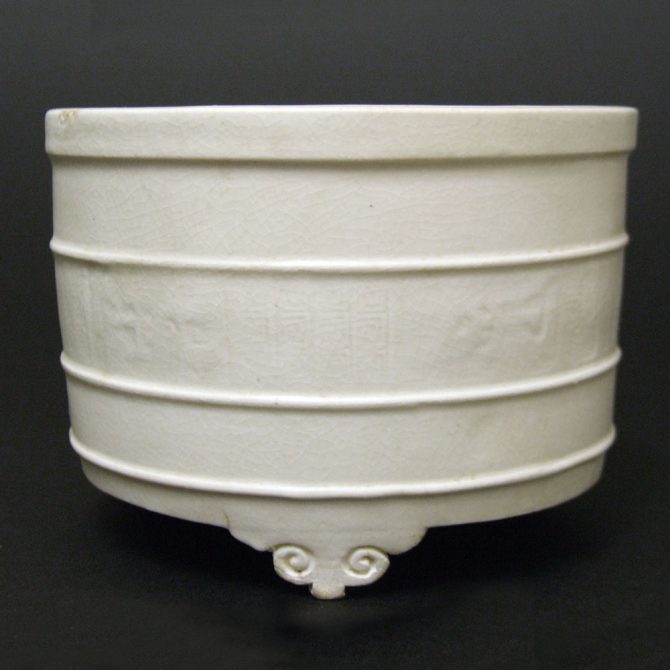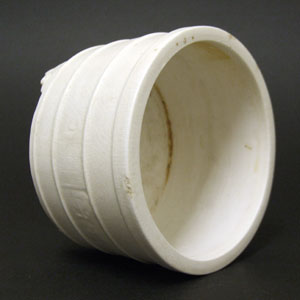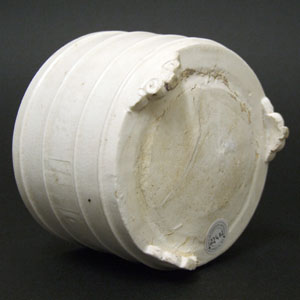
CHONGZHEN c.1643, Hatcher Cargo Ming Blanc de Chine Porcelain
A Rare Ming Blanc de Chine Porcelain Lian, Censer, from the Hatcher Cargo, Chongzhen Period c.1643. The Circular Archaic Bronze Form with Concentric Banding with an Impressed Leiwen Design. This Late Ming Dynasty Incense Burner is Supported on Three Small Bracket Shaped Feet, Probably Representing Ruyi-Heads.
SOLD
- Condition
- Very good, a large firing crack to the base, a shallow firing fault to the top outer rim. The glaze is covered with a fine network of crazing, the degrading to the surface is minor for a blanc de chine object from a shipwreck. Minor iron stains to the unglazed interior.
- Size
- Diameter : 12.2 cm (4 3/4 inches). Height : 8.6 cm (3 1/3 inches)
- Provenance
- N/A
- Stock number
- 22482
- References
- It appears there were only four blanc de chine censers sold from the Hatcher Cargo, see : Fine And Important Late Ming And Transitional Porcelain, Recently Recovered from an Asian Vessel in the South China Sea. Property of Captain Michael Hatcher. Christie`s Amsterdam 14th March 1984, lots 299 to 302. Also see : The Hatcher Porcelain Cargoes, The Complete Record (Colin Sheaf and Richard Kilburn, Phaidon 1988. ISBN 0-7148-80469) page 73, plate 113. For a blanc de chine censer of this type that is not from a shipwreck see our `Sold Items` stock number 21980. For two similar examples see : Blanc de Chine, Porcelain From Dehua, A Catalogue of the Hickley Collection, Singapore (Rose Kerr & John Ayers, Art Media Resources Ltd, 2002) plates 77 and 78. Another incense burner of this type is illustrated in : Blanc de Chine (P.J. Donnelly, Faber and Faber, 1969 (ISBN 571-08078-2) plate 19 B.
Information
Blanc de Chine Porcelain From Shipwrecks :
By far the largest category of ceramics found on shipwrecks is blue and white porcelain from the kilns at Jingdezhen. Blanc de chine porcelain is sometimes found among the cargo`s recovered but the majority of cargo`s don`t contain this white porcelain from the Dehua kilns in Fujian province. Because blanc de chine porcelain is so difficult to date pieces recovered from shipwrecks are especially important in establishing a credible chronology. Many blanc de chine forms were used over a very long time, indeed even over hundreds of years, pieces recovered from shipwrecks enable subtle changes that occurred to be attributed to precise periods. The 579 objects recovered from the Hatcher wreck of c.1643 represent the most important group of blanc de chine porcelain found so far. 439 of the pieces were bowls, most of which were made as nests of five, but many other forms are represented including archetypal blanc de chine forms such as censers, a guanyin, trick cups as well as standard forms such as vases. Small models of guanyin were also recovered from the Vung Tau Cargo of 1690 as well as acolytes from larger guanyin figures. There were many bowls, dishes, boxes with covers as well as a few water-droppers. There was white porcelain found on the wreck of the Geldermalsen, however this Nanking Cargo porcelain came from the Jingdezhen kilns and so is not blanc de chine.

